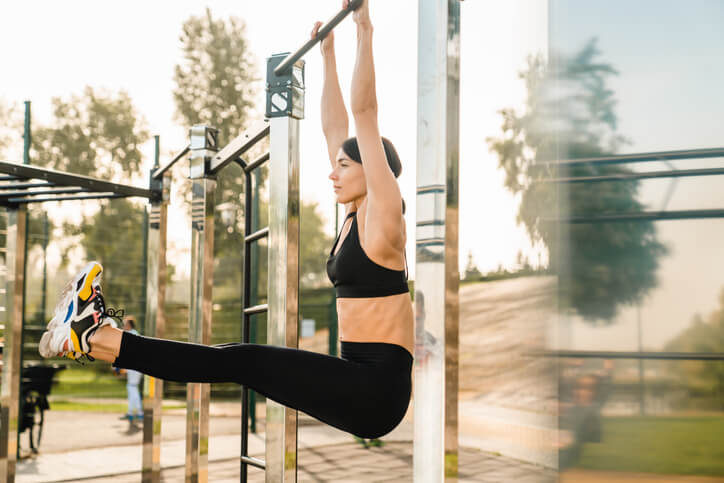Hello, everyone! Today, we’re going to talk about bar exercises for health. The bar is a piece of equipment that can be easily used indoors or outdoors, and it greatly aids in strengthening the whole body and improving flexibility. From now on, let’s explore the basics of bar exercises as well as workout methods for beginners.
1. The Benefits of Bar Exercise
Bar exercise offers a wide variety of benefits, which positively impact various parts of the body. Let’s take a closer look at some of the main benefits in detail.
1.1 Full-body Strength Enhancement
Firstly, bar exercises excel in enhancing full-body strength. It is a compound exercise that activates not only upper body muscles such as arms, shoulders, and back but also abdominal and lower body muscles. In particular, the basic bar exercise called ‘pull-up’ uses most upper body muscles, allowing you to strengthen various muscle groups at once.
1.2 Improvement in Heart and Lung Health
Secondly, bar exercises greatly benefit heart and lung health. Bar exercises that use your own body weight increase your heart rate to activate your cardiovascular system and improve lung function by taking deep breaths. From this perspective, bar exercises bring effective aerobic and circulatory improvement effects.
1.3 Posture Correction and Muscle Balance
Thirdly, bar exercises help with proper posture correction and muscle balance. Today many people suffer from problems like turtle neck syndrome due to computer work or smartphone use. Regular pull-ups or hanging leg raises can greatly alleviate these issues by strengthening back and shoulder muscles for improved posture while also helping to resolve muscle imbalances.
1.4 Enhancing Concentration & Perseverance
Fourthly, bar exercises can greatly assist in enhancing our mental abilities, specifically concentration and perseverance. Bar exercises involve using various muscle groups simultaneously and controlling them requires deep focus. Therefore, regularly performing such exercises naturally improves your concentration.
In addition, bar exercise is one of the more challenging workouts. Initially, it might be difficult to even complete the desired number of repetitions but with consistent practice and repetition, gradual growth is achievable. This process fosters personal perseverance which can positively impact when facing various challenges in everyday life.
1.5 Strengthening Connection with One’s Body
Lastly, bar exercises help to foster a better connection with your body. Lifting and controlling your own body weight is an important indicator of how well different parts of your body can collaborate. Through these experiences, you can heighten awareness of your physical capabilities which significantly contributes to health management and self-care.
The diverse benefits brought by bar exercise make it a sought-after workout for many people. However, always remember safety precautions and proper techniques to enjoy it without injury.
2. Bar Exercise for Beginners
If you’re new to bar exercises, getting started can seem a bit daunting. However, with the right approach and understanding, you can gradually build your strength and proficiency. Here’s a detailed guide on how beginners can start their journey with bar exercises.
2.1 Understanding the Basics
Firstly, it’s crucial to understand what a bar exercise is and how it benefits your body. As mentioned earlier, bar exercises are compound movements that involve lifting your own body weight using a horizontal bar. They primarily target upper body muscles but also engage your core and lower body muscles.
2.2 Starting with Assisted Pull-ups
For beginners, starting directly with pull-ups might be challenging due to the significant upper body strength required. An excellent way to start is by doing assisted pull-ups which reduce the amount of weight you need to lift thereby making the exercise more manageable.
You can use an assisted pull-up machine if available at your gym or use resistance bands looped over the bar for support. These tools help you lift less than your full body weight while still engaging the same muscle groups as in regular pull-ups.
2.3 Gradually Progressing
Once you become comfortable with assisted pull-ups, you can gradually progress towards unassisted ones by reducing assistance over time or switching from machine-assisted ones to band-assisted ones (which offer less support).
It’s important not to rush this process; take as much time as needed until you feel ready for unassisted pull-ups. Remember that consistency and gradual progression are key in fitness training.
2.4 Focusing on Form
While performing any exercise, maintaining proper form is crucial both for maximizing effectiveness and preventing injuries. When doing a pull-up:
- Start from a dead hang position where arms are fully extended.
- Engage your core muscles.
- Pull yourself up until your chin passes above the bar.
- Lower yourself back down in controlled motion without dropping abruptly.
Remember not to kick or swing during this movement; all force should come from pulling up using your upper-body muscles only.
2.5 Incorporating Other Exercises
In addition to practicing assisted and regular pull-ups, incorporating other exercises into your routine will help develop overall strength necessary for successful unassisted pull-ups. Exercises such as pushups (for chest & triceps), bent-over rows (for back), planks (for core), etc., will provide balanced training across various muscle groups thus enhancing overall performance in bar exercises over time.
Starting any new form of workout might seem difficult initially but remember that everyone starts somewhere! Be patient with yourself through this journey of growth in strength & fitness with bar exercises!
3. Precautions for Bar Exercises
While bar exercises offer a myriad of benefits, they also require careful attention to avoid injury and maximize effectiveness. Here are some important precautions to consider when performing bar exercises.
3.1 Warm-Up and Cool-Down
Before starting any strenuous physical activity, it’s essential to warm up your body properly. This can include light cardio exercises such as jogging or jumping jacks, followed by dynamic stretches that mimic the movements you’ll be doing during your workout. This prepares your muscles and joints for the upcoming activity and reduces the risk of injury.
After completing your workout, don’t forget to cool down with static stretching exercises to help relax your muscles and promote recovery.
3.2 Proper Form and Technique
Maintaining proper form is crucial in any exercise, including bar exercises. Incorrect form not only decreases the effectiveness of the exercise but also increases the risk of injuries such as strains or sprains.
When performing pull-ups, ensure that you’re lifting yourself using your upper body strength rather than momentum from swinging or kicking. Your movements should be controlled throughout both ascending (pulling up) and descending (lowering down) phases.
3.3 Gradual Progression
It’s important not to rush progress when it comes to strength training like bar exercises. If you try to do too much too soon – like attempting unassisted pull-ups before having sufficient strength – it can lead to overexertion or injury.
Instead, focus on gradually increasing intensity over time by progressing from assisted pull-ups towards unassisted ones at a pace that feels comfortable for you.
3.4 Listen To Your Body
While it’s normal to experience some level of discomfort during intense workouts like bar exercises, sharp pain is a sign that something might be wrong. If you feel pain during an exercise – especially in joints like shoulders or elbows – stop immediately and seek professional advice if necessary. Never ignore what your body is telling you; recognizing potential issues early can prevent more serious injuries down the line.
3.5 Regular Rest & Recovery
Rest days are equally important as workout days in fitness routines because they allow your muscles time for recovery & growth. Ensure that you’re giving yourself enough rest between workouts involving same muscle groups; working out too frequently without adequate rest can lead not only diminished results but also increased risk of injuries due chronic fatigue or overuse conditions. Additionally, get enough sleep each night as sleep plays a critical role in muscle recovery & overall health!
Remember these precautions while performing bar exercises; they will help make sure that you stay safe while maximizing benefits from this highly effective workout method!








Leave a Reply